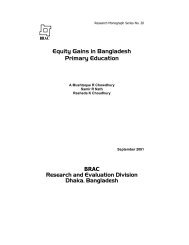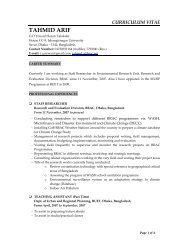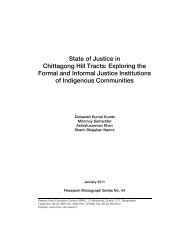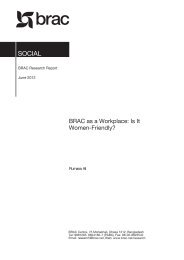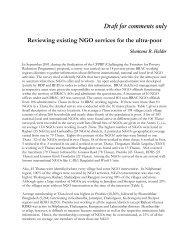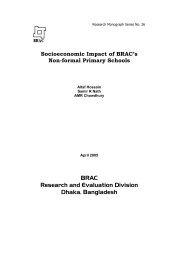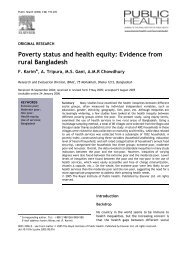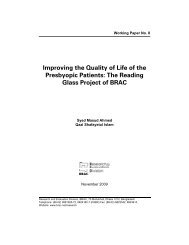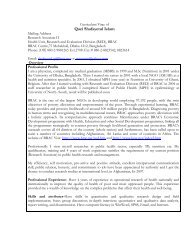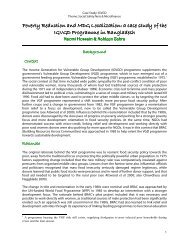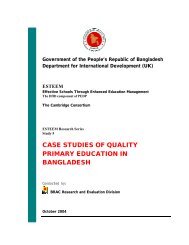Combining health and social protection measures to reach the ultra ...
Combining health and social protection measures to reach the ultra ...
Combining health and social protection measures to reach the ultra ...
You also want an ePaper? Increase the reach of your titles
YUMPU automatically turns print PDFs into web optimized ePapers that Google loves.
Research resources<br />
We encourage o<strong>the</strong>r national governments <strong>to</strong> follow this lead<br />
<strong>and</strong> fund a broad portfolio of research in this area. Some<br />
countries are already supporting <strong>the</strong>ir scientists <strong>to</strong> research <strong>the</strong><br />
male reproductive system <strong>and</strong> develop methods <strong>to</strong> regulate<br />
male fertility, but governments need <strong>to</strong> do more in terms of<br />
funding, networking, partnering <strong>and</strong> political support. It is now<br />
clearly apparent that only through <strong>the</strong> combined efforts of<br />
scientists, not-for-profit research organizations, governments<br />
<strong>and</strong> international organizations will <strong>the</strong> hope of greater access<br />
<strong>to</strong> family planning through delivery of methods for men <strong>to</strong> use<br />
be realized. We are strongly committed <strong>to</strong> this goal <strong>and</strong><br />
encourage greater public-sec<strong>to</strong>r involvement <strong>and</strong> investment in<br />
this important area of research. ❏<br />
The author is a staff member of <strong>the</strong> World Health<br />
Organization. The author alone is responsible for <strong>the</strong> views<br />
expressed in this publication <strong>and</strong> <strong>the</strong>y do not necessarily<br />
represent <strong>the</strong> decisions or <strong>the</strong> stated policy of <strong>the</strong> World Health<br />
Organization.<br />
Kirsten M Vogelsong is a scientist in <strong>the</strong> Department of<br />
Reproductive Health <strong>and</strong> Research at <strong>the</strong> World Health Organization<br />
in Geneva, Switzerl<strong>and</strong>. She manages a portfolio of activities related<br />
<strong>to</strong> <strong>the</strong> research <strong>and</strong> development of new methods of contraception,<br />
with a focus on male sexual <strong>and</strong> reproductive <strong>health</strong> <strong>and</strong> fertility<br />
regulation. Dr Vogelsong received a BA degree from Penn State <strong>and</strong><br />
a PhD in Neurobiology <strong>and</strong> Physiology from Northwestern University.<br />
She has previously worked in academic research labora<strong>to</strong>ries <strong>and</strong> in<br />
project management at <strong>the</strong> United States Agency for International<br />
Development’s Office of Population.<br />
Henry L Gabelnick is <strong>the</strong> Executive Direc<strong>to</strong>r of CONRAD <strong>and</strong> also<br />
a professor in <strong>the</strong> Department of Obstetrics <strong>and</strong> Gynaecology at<br />
Eastern Virginia Medical School. CONRAD has as its mission <strong>the</strong><br />
improvement of reproductive <strong>health</strong> with emphasis on developing<br />
countries. Dr Gabelnick received BS <strong>and</strong> MS degrees from MIT <strong>and</strong><br />
his PhD from Prince<strong>to</strong>n University. He currently is <strong>the</strong> President of<br />
<strong>the</strong> Society for <strong>the</strong> Advancement of Reproductive Care. He has also<br />
served on <strong>the</strong> boards of <strong>the</strong> Alliance for Microbicide Development,<br />
Biosyn, Inc. <strong>and</strong> <strong>the</strong> International Partnership for Microbicides.<br />
Eberhard Nieschlag is currently President of <strong>the</strong> German Society<br />
of Andrology. Following his studies of Medicine in Bonn <strong>and</strong> Munich<br />
<strong>and</strong> Biochemistry in London, Professor Nieschlag worked at various<br />
departments of Internal Medicine of University Hospitals in Germany<br />
<strong>and</strong> at <strong>the</strong> Reproduction Research Branch at <strong>the</strong> NIH in Be<strong>the</strong>sda.<br />
He is specialized in internal medicine, endocrinology <strong>and</strong> <strong>and</strong>rology.<br />
He was Direc<strong>to</strong>r of <strong>the</strong> Max-Planck Clinical Research Unit for<br />
Reproductive Medicine at <strong>the</strong> University of Muenster from 1980 <strong>to</strong><br />
1988 <strong>and</strong> has since <strong>the</strong>n been Direc<strong>to</strong>r of <strong>the</strong> Institute of<br />
Reproductive Medicine of <strong>the</strong> University of Münster, which is a longst<strong>and</strong>ing<br />
WHO Collaborating Centre for Research in Male<br />
Reproduction <strong>and</strong> a training centre of <strong>the</strong> European Academy of<br />
Andrology. For many years, Professor Nieschlag was a member of <strong>the</strong><br />
WHO Steering Committee for <strong>the</strong> Regulation of Male Fertility <strong>and</strong><br />
was its Chairman from 1985 <strong>to</strong> 1990. He was President of <strong>the</strong><br />
German Society of Endocrinology, <strong>the</strong> International Society of<br />
Andrology, <strong>the</strong> European Academy of Andrology <strong>the</strong> German Society<br />
for Reproductive Medicine. The most recent of <strong>the</strong> many awards<br />
Professor Nieschlag received is <strong>the</strong> Distinguished Andrologist 2007<br />
of <strong>the</strong> American Society of Andrology.<br />
References<br />
1.<br />
United Nations Department of Economic <strong>and</strong> Social Affairs, Population<br />
Division. World Contraceptive Use 2005, 2005. Available at website<br />
http://www.un.org/esa/population/publications/contraceptive2005/WCU2005.h<br />
tm (accessed July 2007).<br />
2.<br />
Return of <strong>the</strong> Population Growth Fac<strong>to</strong>r – Its Impact Upon <strong>the</strong> Millennium<br />
Development Goals, 2007. Report of hearings by <strong>the</strong> All Party Parliamentary<br />
Group on Population, Development <strong>and</strong> Reproductive Health, House of<br />
Commons, London.<br />
3.<br />
The World Bank. Population issues in <strong>the</strong> 21st century – <strong>the</strong> role of <strong>the</strong> World<br />
Bank. Health, Nutrition <strong>and</strong> Population Discussion Paper, 2007.<br />
4.<br />
Heinemann K et al. Attitudes <strong>to</strong>ward male fertility control: results of a<br />
multinational survey on four continents. Human Reproduction, 2005,<br />
20(2):549-556.<br />
5.<br />
Martin CW et al. Potential impact of hormonal male contraception: crosscultural<br />
implications for development of novel preparations. Human<br />
Reproduction, 2000, 15(3):637-645.<br />
6.<br />
ICPD Programme of Action, paragraph 12.14. Available at website<br />
http://www.unfpa.org/icpd/icpd_poa.htm#ch12b (accessed July 2007).<br />
7.<br />
Gardner R, Blackburn RD, Upadhay UD. Closing <strong>the</strong> condom gap. Population<br />
Reports, April 1999, Series H, No 9. Baltimore, Johns Hopkins University<br />
School of Public Health, Population Information Program.<br />
8.<br />
Upadhay UD. New contraceptive choices. Population Reports, April 2005,<br />
Series M, No. 19. Baltimore, Johns Hopkins Bloomberg School of Public<br />
Health, The INFO project. Available at website<br />
http://www.populationreports.org/m19/<br />
9.<br />
Lohiya NK et al. Vas deferens, a site of male contraception: an overview.<br />
Asian Journal of Andrology, 2001, 3:87-95.<br />
10.<br />
Sokal DC. Recent research on vasec<strong>to</strong>my techniques. Asian Journal of<br />
Andrology, 2003, 5:227-230.<br />
11.<br />
World Health Organization Task Force on Methods for <strong>the</strong> Regulation of Male<br />
Fertility. Contraceptive efficacy of tes<strong>to</strong>sterone-induced azoospermia in normal<br />
men. The Lancet, 1990, 336:955-959.<br />
12.<br />
World Health Organization Task Force on Methods for <strong>the</strong> Regulation of Male<br />
Fertility. Contraceptive efficacy of tes<strong>to</strong>sterone-induced azoospermia <strong>and</strong><br />
oligozoospermia in normal men. Fertility <strong>and</strong> Sterility, 1996, 65:821-829.<br />
13.<br />
Gu Y-Q et al. A multicenter contraceptive efficacy study of injectable<br />
tes<strong>to</strong>sterone undecanoate in <strong>health</strong>y Chinese men. Journal of Clinical<br />
Endocrinology & Metabolism, 2003, 88:562-568.<br />
14.<br />
Meriggiola MC, Farley TM, Mbizvo MT. A review of <strong>and</strong>rogen-progestin<br />
regimens for male contraception. Journal of Andrology, 2003,<br />
24(4):466-483.<br />
15.<br />
Wenk M, Nieschlag E. Male contraception: a realistic option? European<br />
Journal of Contraception <strong>and</strong> Reproductive Health Care, 2006,<br />
11:69-80.<br />
16.<br />
Kamischke A et al. Intramuscular tes<strong>to</strong>sterone undecanoate <strong>and</strong><br />
norethisterone enanthate in a clinical trial for male contraception. Journal of<br />
Clinical Endocrinology & Metabolism, 2001, 86:303-309.<br />
17.<br />
Kamischke A et al. An effective hormonal male contraceptive using<br />
tes<strong>to</strong>sterone undecanoate with oral or injectable norethisterone preparations.<br />
Journal of Clinical Endocrinology & Metabolism, 2002, 87:530-539.<br />
18.<br />
Meriggiola MC et al. Norethisterone enanthate plus tes<strong>to</strong>sterone undecanoate<br />
for male contraception: effects of varions injection intervals on<br />
sperma<strong>to</strong>genesis, reproductive hormones, testis <strong>and</strong> prostate. Journal of<br />
Clinical Endocrinology & Metabolism, 2005, 90:2005-2014.<br />
19.<br />
Nieschlag E, Behre HM. Tes<strong>to</strong>sterone in male contraception. In: Nieschlag <strong>and</strong><br />
Behre (eds), Tes<strong>to</strong>sterone: Action, Deficiency, Substitution, 2nd edition,<br />
1998, Springer Heidelberg, pp.513-528.<br />
20.<br />
10th Summit Meeting Consensus: Recommendations for regula<strong>to</strong>ry approval<br />
for hormonal male contraception. International Journal of Andrology, 2007,<br />
30:63-64.<br />
130 ✜ Global Forum Update on Research for Health Volume 4



